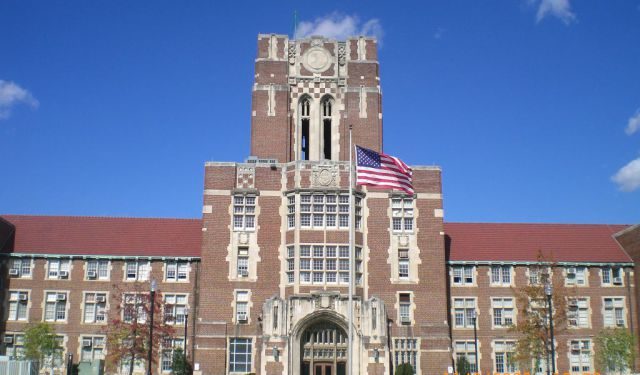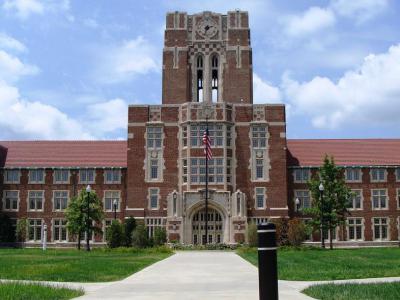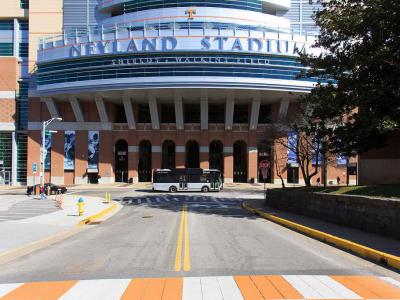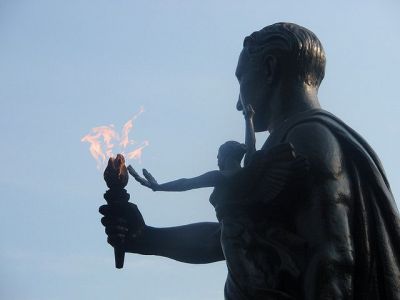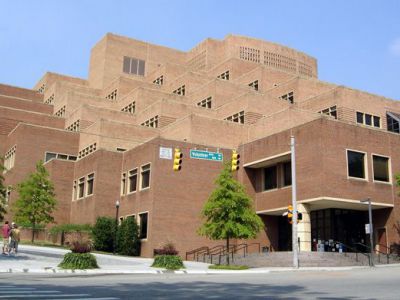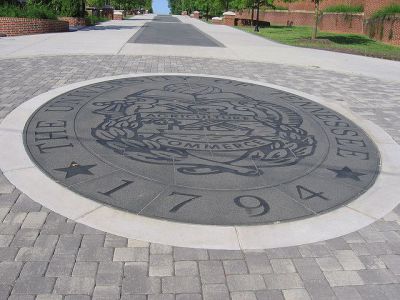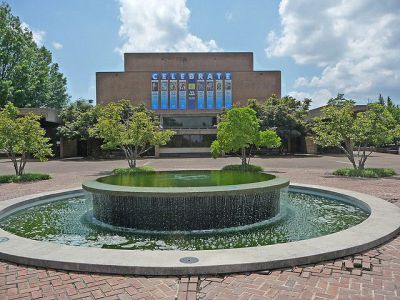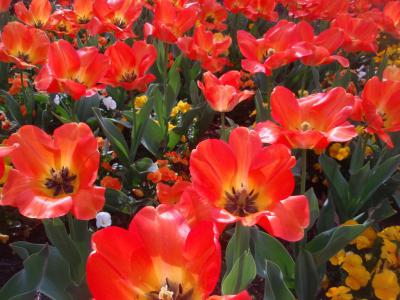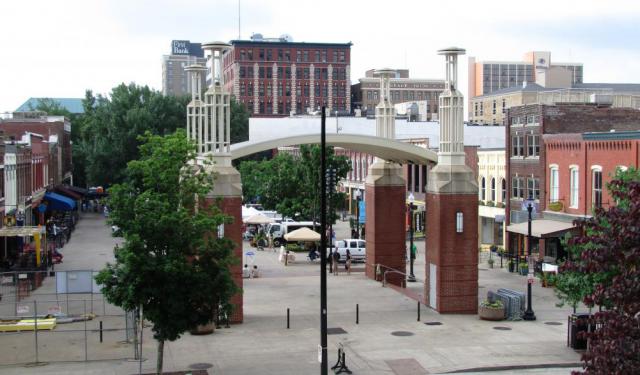University of Tennessee Walking Tour (Self Guided), Knoxville
Founded in 1794 as William Blount College, The University of Tennessee (UT) in Knoxville is one of the oldest public universities in the United States. Nowadays, the UT flagship institution features a mix of historic and modern sites which draw many a visitor to the city.
The campus covers nearly 600 acres in downtown’s west end, including over 200 buildings and a faculty of more than 1,700 academic staff, and has no shortage of interesting things to see and do.
Topping the list of notable attractions of the "Big Orange" (a popular nickname for UT, derived from the school's distinctive shade of orange prominently featured on its sports uniforms and other branding materials) is Neyland Stadium, home to the university's football team and one of the largest sports arenas in the country. "Rocky Top", the university's official “fight” song, is a popular tune among UT fans and is often played at sporting events and other university gatherings.
Among other iconic locations to check out is Ayres Hall, with its distinctive clock tower, found in the historic part of the campus, known as "The Hill". The multi-level Hodges Library is a standalone architectural landmark, while the UT Gardens are another beautiful spot to explore, boasting a wide variety of plants on display.
In addition to these attractions, the UT campus also features a vibrant arts community. The Clarence Brown Theatre hosts a variety of shows throughout the year, including plays, musicals, and dance performances.
"Vols for Life" is a popular phrase among UT alumni which is often used to express their lifelong commitment to the university and its values. To find out what they are and to feel this dynamic place from within, if only for a brief moment, consider taking this self-guided walk.
The campus covers nearly 600 acres in downtown’s west end, including over 200 buildings and a faculty of more than 1,700 academic staff, and has no shortage of interesting things to see and do.
Topping the list of notable attractions of the "Big Orange" (a popular nickname for UT, derived from the school's distinctive shade of orange prominently featured on its sports uniforms and other branding materials) is Neyland Stadium, home to the university's football team and one of the largest sports arenas in the country. "Rocky Top", the university's official “fight” song, is a popular tune among UT fans and is often played at sporting events and other university gatherings.
Among other iconic locations to check out is Ayres Hall, with its distinctive clock tower, found in the historic part of the campus, known as "The Hill". The multi-level Hodges Library is a standalone architectural landmark, while the UT Gardens are another beautiful spot to explore, boasting a wide variety of plants on display.
In addition to these attractions, the UT campus also features a vibrant arts community. The Clarence Brown Theatre hosts a variety of shows throughout the year, including plays, musicals, and dance performances.
"Vols for Life" is a popular phrase among UT alumni which is often used to express their lifelong commitment to the university and its values. To find out what they are and to feel this dynamic place from within, if only for a brief moment, consider taking this self-guided walk.
How it works: Download the app "GPSmyCity: Walks in 1K+ Cities" from Apple App Store or Google Play Store to your mobile phone or tablet. The app turns your mobile device into a personal tour guide and its built-in GPS navigation functions guide you from one tour stop to next. The app works offline, so no data plan is needed when traveling abroad.
University of Tennessee Walking Tour Map
Guide Name: University of Tennessee Walking Tour
Guide Location: USA » Knoxville (See other walking tours in Knoxville)
Guide Type: Self-guided Walking Tour (Sightseeing)
# of Attractions: 7
Tour Duration: 2 Hour(s)
Travel Distance: 3.0 Km or 1.9 Miles
Author: Sandra
Sight(s) Featured in This Guide:
Guide Location: USA » Knoxville (See other walking tours in Knoxville)
Guide Type: Self-guided Walking Tour (Sightseeing)
# of Attractions: 7
Tour Duration: 2 Hour(s)
Travel Distance: 3.0 Km or 1.9 Miles
Author: Sandra
Sight(s) Featured in This Guide:
- Ayres Hall
- Neyland Stadium
- Volunteer Statue and Circle Park
- John C. Hodges Library
- University Pedestrian Mall
- Clarence Brown Theatre and Carousel Theatre
- University of Tennessee Gardens
1) Ayres Hall
At the University of Tennessee (UT) in Knoxville, the iconic and historic Ayres Hall stands as a central landmark. The building was completed in 1921, designed by Miller, Fullenwider, and Dowling of Chicago, and named after Brown Ayres, UT's 12th president, from 1904 to 1909.
In 2008, an extensive restoration project began and ended in January 2011, adding central air conditioning and heating, terrazzo floors and benches, clock faces for the tower, refurbished classroom furnishings, and a north courtyard.
The Gothic Revival structure is 140 feet (43 m) tall, with a distinctive checkerboard feature at the top of the tower replicated in UT Orange and white at Neyland Stadium and Thompson-Boling Arena. The College of Arts and Sciences offices and UT's mathematics department are located in the building. The clock faces and terrazzo floors were in the original designs, while the north courtyard was not part of the original plan.
In 2008, an extensive restoration project began and ended in January 2011, adding central air conditioning and heating, terrazzo floors and benches, clock faces for the tower, refurbished classroom furnishings, and a north courtyard.
The Gothic Revival structure is 140 feet (43 m) tall, with a distinctive checkerboard feature at the top of the tower replicated in UT Orange and white at Neyland Stadium and Thompson-Boling Arena. The College of Arts and Sciences offices and UT's mathematics department are located in the building. The clock faces and terrazzo floors were in the original designs, while the north courtyard was not part of the original plan.
2) Neyland Stadium
Neyland Stadium is a football stadium located in Knoxville, on the campus of the University of Tennessee. The stadium is named after Robert Neyland, who was a legendary football coach at the university. With a seating capacity of over 102,000, it is the fifth-largest stadium in the United States and the seventh-largest in the world.
The stadium was originally built in 1921 and underwent several renovations over the years to accommodate more fans and improve the facility. One of the most significant renovations was completed in 2010, which added new seats, luxury suites, and a larger video board.
Neyland Stadium has a rich history, having hosted numerous important football games over the years. It is the home stadium of the Tennessee Volunteers football team and has also hosted games for the Tennessee Titans of the National Football League (NFL). The stadium has also hosted various concerts and other events, including the 1982 World's Fair.
One of the unique features of Neyland Stadium is the "Vol Navy," which is a flotilla of boats that anchor on the Tennessee River on game days. Fans arrive at the stadium via the river, making for a unique and exciting atmosphere.
The stadium is also known for its iconic checkerboard end zones, which have become a symbol of the Tennessee football program. The stadium's seating bowl is also designed to maximize crowd noise, making it a challenging place for opposing teams to play.
The stadium was originally built in 1921 and underwent several renovations over the years to accommodate more fans and improve the facility. One of the most significant renovations was completed in 2010, which added new seats, luxury suites, and a larger video board.
Neyland Stadium has a rich history, having hosted numerous important football games over the years. It is the home stadium of the Tennessee Volunteers football team and has also hosted games for the Tennessee Titans of the National Football League (NFL). The stadium has also hosted various concerts and other events, including the 1982 World's Fair.
One of the unique features of Neyland Stadium is the "Vol Navy," which is a flotilla of boats that anchor on the Tennessee River on game days. Fans arrive at the stadium via the river, making for a unique and exciting atmosphere.
The stadium is also known for its iconic checkerboard end zones, which have become a symbol of the Tennessee football program. The stadium's seating bowl is also designed to maximize crowd noise, making it a challenging place for opposing teams to play.
3) Volunteer Statue and Circle Park
Located off Volunteer Boulevard, behind the Volunteer Statue, Circle Park is a recreational area on the campus of the University of Tennessee. Originally named Payne Circle, the central portion of the park was given to the City of West Knoxville in 1888 and became its property on January 4, 1889. Before the late-1960s' the westward expansion of the university, the park was surrounded by beautiful homes, some of which had been sold to fraternities, and the area served as a neighborhood park. Circle Park was once considered a possible site for the new university hospital.
In April 1968, the Volunteer Statue was installed, and in 1974, Circle Park was upgraded using a plan created by landscape architect Bill Oliphant. The plaza for the Volunteer Statue was a major feature of the enhanced Circle Park. The statue, also known as the Torchbearer, was unveiled in 1968, over three decades after it became UT's official symbol. The sculptor, Theodore Andre Beck, was selected as the winner of a contest in 1931 to create a symbol of a Volunteer.
The park underwent additional upgrades in 2004 with new lighting and brick walkways. In the summer of 2015, a significant renovation was undertaken for the entire park, which included improving the Volunteer Statue plaza area and retaining wall and replacing the park's grass with XtraGrass. XtraGrass is a new type of landscaping that blends and reinforces natural grass with artificial turf, offering the look and feel of natural grass with increased resistance to wear. The product was developed by UT and Astroturf and was donated to UT for the project.
In April 1968, the Volunteer Statue was installed, and in 1974, Circle Park was upgraded using a plan created by landscape architect Bill Oliphant. The plaza for the Volunteer Statue was a major feature of the enhanced Circle Park. The statue, also known as the Torchbearer, was unveiled in 1968, over three decades after it became UT's official symbol. The sculptor, Theodore Andre Beck, was selected as the winner of a contest in 1931 to create a symbol of a Volunteer.
The park underwent additional upgrades in 2004 with new lighting and brick walkways. In the summer of 2015, a significant renovation was undertaken for the entire park, which included improving the Volunteer Statue plaza area and retaining wall and replacing the park's grass with XtraGrass. XtraGrass is a new type of landscaping that blends and reinforces natural grass with artificial turf, offering the look and feel of natural grass with increased resistance to wear. The product was developed by UT and Astroturf and was donated to UT for the project.
4) John C. Hodges Library
The John C. Hodges Library, located on Volunteer Boulevard, is the main library of the University of Tennessee. It was established in 1969 and is named after Dr. John Cunyus Hodges, who taught English at UT for 41 years and was a generous donor to the university's libraries. The library's collection comprises over 3 million books, periodicals, and computer resources, including a rare book collection with around 60,000 items, some of which date back to 1481 AD. The University of Tennessee Libraries provides students and researchers with a range of resources, including books, articles, media, technology, spaces, and research expertise.
The Hodges Library's first-floor galleria features several permanent exhibits, such as The Centaur Excavations at Volos, a bronze bust of the late author Alex Haley, and the Alumni Academic Hall of Fame honoring UT alumni. The second floor, known as The Commons, is a collaborative space that provides students with resources such as a media production lab, research assistance, group meeting spaces, and technology services.
The third floor of the library houses the Center for Children's & Young Adult Literature, which features a non-circulating collection of children's and young adult literature that the community is welcome to read on-site. It also houses the Children's and Young Adult Collection, which circulates.
The library's design allows for ample natural light and features Italian and Spanish marble and lightly finished wood. In 1987, the library underwent an expansion that added nearly 250,000 square feet to the original 1969 construction.
The Hodges Library's first-floor galleria features several permanent exhibits, such as The Centaur Excavations at Volos, a bronze bust of the late author Alex Haley, and the Alumni Academic Hall of Fame honoring UT alumni. The second floor, known as The Commons, is a collaborative space that provides students with resources such as a media production lab, research assistance, group meeting spaces, and technology services.
The third floor of the library houses the Center for Children's & Young Adult Literature, which features a non-circulating collection of children's and young adult literature that the community is welcome to read on-site. It also houses the Children's and Young Adult Collection, which circulates.
The library's design allows for ample natural light and features Italian and Spanish marble and lightly finished wood. In 1987, the library underwent an expansion that added nearly 250,000 square feet to the original 1969 construction.
5) University Pedestrian Mall
The University Pedestrian Mall is a granite walkway that connects the Humanities Department with Hodges Library. The University constructed this pedestrian mall to create a more pedestrian-friendly campus and foster a sense of community. By repurposing a previously inaccessible section of a major avenue and adjacent open spaces, the University has established a green pedestrian core that connects several once-isolated areas of the campus. This connectivity enhances the feeling of belonging for students, faculty, and visitors alike.
The pedestrian mall stretches from the primary campus intersection, through high-traffic academic buildings and campus theaters, all the way to the dormitory area. The mall includes a central hilltop plaza, a casual amphitheater, a memorial plaza, a sculpture garden, enhanced pedestrian access to critical campus areas, an abundance of tree plantings, small pedestrian gathering areas with seating, improved site lighting, and new street furniture. This new pedestrian core for the campus is sure to create a more welcoming and enjoyable environment for all.
The pedestrian mall stretches from the primary campus intersection, through high-traffic academic buildings and campus theaters, all the way to the dormitory area. The mall includes a central hilltop plaza, a casual amphitheater, a memorial plaza, a sculpture garden, enhanced pedestrian access to critical campus areas, an abundance of tree plantings, small pedestrian gathering areas with seating, improved site lighting, and new street furniture. This new pedestrian core for the campus is sure to create a more welcoming and enjoyable environment for all.
6) Clarence Brown Theatre and Carousel Theatre
Built in 1970, the Clarence Brown Theatre is a proscenium theater located in the heart of the University of Tennessee campus and is named after the distinguished film director and UT alumnus, Clarence Brown. The theater is equipped with extensive collections of costumes and properties, as well as shops for lighting, sound, scenery, and costumes. It is designed to provide access and seating for people with disabilities and offers listening systems for the deaf and hearing-impaired.
The Department of Speech and Drama at the University of Tennessee uses the Clarence Brown Theatre as a teaching and presentation facility. The theater includes a main seating area that can accommodate up to 600 people and a smaller 120-seat theater for more intimate productions. The seating is arranged in a continental style to promote a sense of unity, without any disruptive aisles. This design allows for both experimental and traditional productions to be staged.
Adjacent to the Clarence Brown Theatre is the Ula Love Doughty Carousel Theatre, a versatile 400-seat arena space with flexible seating and staging. It was renamed in honor of Ula Love Doughty, a dedicated patron who helped secure the theater's future. The Carousel Theatre is possibly the oldest intact theater-in-the-round in America and is located in an area of campus known for modernist structures made of brick and concrete.
The Department of Speech and Drama at the University of Tennessee uses the Clarence Brown Theatre as a teaching and presentation facility. The theater includes a main seating area that can accommodate up to 600 people and a smaller 120-seat theater for more intimate productions. The seating is arranged in a continental style to promote a sense of unity, without any disruptive aisles. This design allows for both experimental and traditional productions to be staged.
Adjacent to the Clarence Brown Theatre is the Ula Love Doughty Carousel Theatre, a versatile 400-seat arena space with flexible seating and staging. It was renamed in honor of Ula Love Doughty, a dedicated patron who helped secure the theater's future. The Carousel Theatre is possibly the oldest intact theater-in-the-round in America and is located in an area of campus known for modernist structures made of brick and concrete.
7) University of Tennessee Gardens (must see)
The University of Tennessee Gardens (UT Gardens) is Tennessee's official State Botanical Garden. These public gardens offer a diverse range of native flora along picturesque pathways and verdant lawns. Visitors can explore the Children's Gardens, the Arboretum Walk, the Perennial Garden, the Annual Trials, the Wetlands, and many other attractions. Moreover, Knoxville's Neyland Greenway provides easy access to the Gardens from both UT Campus and Downtown.
In 2013, the Gardens were designated as the official botanical gardens of Tennessee. UT Gardens are open year-round and showcase around 4,000 plants, including annuals, perennials, herbs, tropicals, trees, shrubs, vegetables, and ornamental grasses.
UT Gardens also provide unparalleled opportunities for University students, faculty, and researchers to study these plants in the onsite greenhouse and laboratory facilities. The Gardens regularly host youth programs, summer camps, workshops, and special events.
As an outdoor laboratory, the UT Gardens provide a platform to evaluate the performance and landscaping potential of various plant species. The location's unique weather conditions also make it ideal for testing plants under extreme heat, humidity, and variable winters. Leading commercial seed and plant companies around the globe rely on UT Gardens for information on plants that eventually reach the commercial market.
In 2013, the Gardens were designated as the official botanical gardens of Tennessee. UT Gardens are open year-round and showcase around 4,000 plants, including annuals, perennials, herbs, tropicals, trees, shrubs, vegetables, and ornamental grasses.
UT Gardens also provide unparalleled opportunities for University students, faculty, and researchers to study these plants in the onsite greenhouse and laboratory facilities. The Gardens regularly host youth programs, summer camps, workshops, and special events.
As an outdoor laboratory, the UT Gardens provide a platform to evaluate the performance and landscaping potential of various plant species. The location's unique weather conditions also make it ideal for testing plants under extreme heat, humidity, and variable winters. Leading commercial seed and plant companies around the globe rely on UT Gardens for information on plants that eventually reach the commercial market.
Walking Tours in Knoxville, Tennessee
Create Your Own Walk in Knoxville
Creating your own self-guided walk in Knoxville is easy and fun. Choose the city attractions that you want to see and a walk route map will be created just for you. You can even set your hotel as the start point of the walk.
Knoxville’s Historical Buildings
Knoxville is often referred to as "The Marble City" for the abundant supply of high-quality marble used in many of its buildings. Noting the wealth of well-preserved historic homes in the city, prominent American architect John Russell Pope even coined his own moniker for it – the "City of Houses".
Indeed, Knoxville's eventful and sometimes turbulent past, dating from... view more
Tour Duration: 2 Hour(s)
Travel Distance: 2.2 Km or 1.4 Miles
Indeed, Knoxville's eventful and sometimes turbulent past, dating from... view more
Tour Duration: 2 Hour(s)
Travel Distance: 2.2 Km or 1.4 Miles
Downtown Knoxville Walking Tour
A small town with big-city amenities and a vibrant music scene (a mix of country, bluegrass, and rock), Knoxville, or K-Town as it's popularly shortened by locals, is also often referred to as “the Gateway to the Great Smoky Mountains,” for its proximity to the national park area, whose marble quarries, in the past, gave it another moniker, The Marble City.
Knoxville was founded in... view more
Tour Duration: 2 Hour(s)
Travel Distance: 2.3 Km or 1.4 Miles
Knoxville was founded in... view more
Tour Duration: 2 Hour(s)
Travel Distance: 2.3 Km or 1.4 Miles
The Most Popular Cities
/ view all
